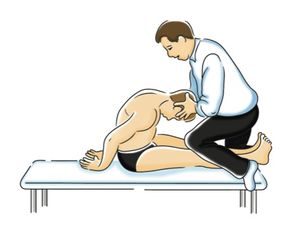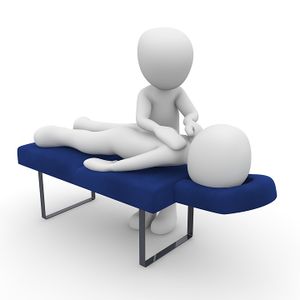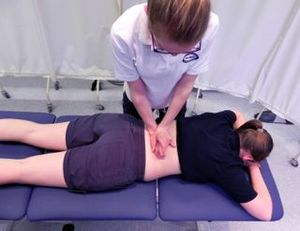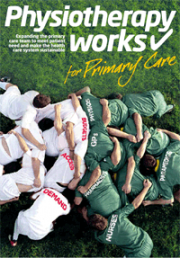Manual Therapy: Difference between revisions
m (OMPT definition updates from IFOMPT and links to descriptions of practice in AAOMPT) |
(AAOMPT DASP definition of OMPT 2018) |
||
| Line 9: | Line 9: | ||
The International Federation of Orthopaedic Manipulative Physical Therapists ([http://www.ifompt.com/ IFOMPT]) defines orthopaedic manual physical therapy as: "a ''specialised area of [[Manual Therapy#PhysicalTherapyPhysiotherapy|physiotherapy]]/[[Manual Therapy#PhysicalTherapyPhysiotherapy|Physical Therapy]] for the management of NMS conditions, based on [[Manual Therapy#ClinicalReasoning|clinical reasoning]], using highly specific [[Manual Therapy#Treatment|treatment]] approaches including manual techniques and [[Manual Therapy#TherapeuticExercise|therapeutic exercise]]<nowiki/>s. Orthopaedic Manual Therapy also encompasses, and is driven by, the available scientific and clinical evidence and the [[Manual Therapy#Biopsychosocial|biopsychosocial]] framework of each individual patient''" | The International Federation of Orthopaedic Manipulative Physical Therapists ([http://www.ifompt.com/ IFOMPT]) defines orthopaedic manual physical therapy as: "a ''specialised area of [[Manual Therapy#PhysicalTherapyPhysiotherapy|physiotherapy]]/[[Manual Therapy#PhysicalTherapyPhysiotherapy|Physical Therapy]] for the management of NMS conditions, based on [[Manual Therapy#ClinicalReasoning|clinical reasoning]], using highly specific [[Manual Therapy#Treatment|treatment]] approaches including manual techniques and [[Manual Therapy#TherapeuticExercise|therapeutic exercise]]<nowiki/>s. Orthopaedic Manual Therapy also encompasses, and is driven by, the available scientific and clinical evidence and the [[Manual Therapy#Biopsychosocial|biopsychosocial]] framework of each individual patient''" | ||
According to the American Academy of Orthopaedic Manual Physical Therapists ([http://www.aaompt.org/ AAOMPT]) Description of Advanced Specialty Practice ([ | According to the American Academy of Orthopaedic Manual Physical Therapists ([http://www.aaompt.org/ AAOMPT]) Description of Advanced Specialty Practice ([https://aaompt.org/aaompt_data/documents/DASP_October_2018.pdf DASP]) (2018), orthopaedic manual physical therapy (OMPT) is defined as: “an advanced specialty area of physical therapy practice that is based on manual examination and treatment techniques integrated with exercise, patient education, and other physical therapy modalities to address pain, loss of function, and wellness. | ||
Early, consistent, and skillful manual physical therapy, combined with exercise and patient education, is central to the OMPT therapist’s practice. Advanced examination, communication, and decision-making skills that are built on the foundations of professional and scientific education facilitate the provision of effective and efficient care. Practitioners of OMPT provide patient management, consult with other health care providers regarding simple as well as complex neuromusculoskeletal (NMS) conditions, and provide recommendations and interventions in the area of health and wellness."{{#ev:youtube|https://www.youtube.com/watch?v=X6q5i0L89-M&app=desktop|width}}<ref>Antonio Sanson What is Manual Therapy | Do PTA's Give Massage? Available from: https://www.youtube.com/watch?v=X6q5i0L89-M&app=desktop (last accessed 21.9.2019)</ref> | |||
{{#ev:youtube|https://www.youtube.com/watch?v=X6q5i0L89-M&app=desktop|width}}<ref>Antonio Sanson What is Manual Therapy | Do PTA's Give Massage? Available from: https://www.youtube.com/watch?v=X6q5i0L89-M&app=desktop (last accessed 21.9.2019)</ref> | |||
== Three Paradigms for Manual Therapy Therapeutic Effects == | == Three Paradigms for Manual Therapy Therapeutic Effects == | ||
Revision as of 14:26, 13 August 2021
Original Editor - Finn Gerstell
Top Contributors - Finn Gerstell, Jess Bell, Admin, Kim Jackson, Lucinda hampton, Dana Tew, Samuel Winter, Carin Hunter, Rachael Lowe, Elaine Lonnemann, Mande Jooste, David Drinkard, Hanz Tao, Matt Huey, WikiSysop, Shaimaa Eldib, Scott Buxton, Kai A. Sigel and Rucha Gadgil
Description[edit | edit source]
Manual therapy has a long history within the profession of physical therapy and physical therapists have greatly contributed to the current diversity in manual therapy approaches and techniques. Mechanical explanations were historically used to explain the mechanisms by which manual therapy interventions worked. Contemporary research reveals intricate neurophysiologic mechanisms are also at play and the beneficial psychological effects of providing hands-on examination and intervention have been substantiated.[1]
The International Federation of Orthopaedic Manipulative Physical Therapists (IFOMPT) defines orthopaedic manual physical therapy as: "a specialised area of physiotherapy/Physical Therapy for the management of NMS conditions, based on clinical reasoning, using highly specific treatment approaches including manual techniques and therapeutic exercises. Orthopaedic Manual Therapy also encompasses, and is driven by, the available scientific and clinical evidence and the biopsychosocial framework of each individual patient"
According to the American Academy of Orthopaedic Manual Physical Therapists (AAOMPT) Description of Advanced Specialty Practice (DASP) (2018), orthopaedic manual physical therapy (OMPT) is defined as: “an advanced specialty area of physical therapy practice that is based on manual examination and treatment techniques integrated with exercise, patient education, and other physical therapy modalities to address pain, loss of function, and wellness.
Early, consistent, and skillful manual physical therapy, combined with exercise and patient education, is central to the OMPT therapist’s practice. Advanced examination, communication, and decision-making skills that are built on the foundations of professional and scientific education facilitate the provision of effective and efficient care. Practitioners of OMPT provide patient management, consult with other health care providers regarding simple as well as complex neuromusculoskeletal (NMS) conditions, and provide recommendations and interventions in the area of health and wellness."
Three Paradigms for Manual Therapy Therapeutic Effects[edit | edit source]
- Physiological: positive placebo response
- Biomechanical and Physical: facilitates repair and tissue modelling
- Psychological: pain relief via- stimulates gating mechanism; muscle inhibition; reduction of nocioceptive activity; reduced intraarticular or periarticular pressure[3]
Techniques Include[edit | edit source]
- Traction
- Massage
- Trigger Point Therapy
- Active Release Techniques: A practitioner determines where adhesions are through touch, the practitioner then couples a patient's active movement with his/her touch. [4]
- Assisted Active Range of Motion (AAROM)
- Passive Range of Motion
- Lymph Drainage
- Stretches (muscle, neural tissue, joints, fascia)
- Instrument Assisted Soft Tissue Mobilization
- Joint Manipulation: A passive, high velocity, low amplitude thrust applied to a joint complex within its anatomical limit* with the intent to restore optimal motion, function, and/ or to reduce pain.[5]
- Joint Mobilisation: A manual therapy technique comprising a continuum of skilled passive movements to the joint complex that are applied at varying speeds and amplitudes, that may include a small-amplitude/ high-velocity therapeutic movement (manipulation) with the intent to restore optimal motion, function, and/ or to reduce pain.[5]
NB The terms "Thrust Manipulation" and "Non-Thrust Manipulation" have been used in the literature. "Thrust Manipulation" is used to describe interventions described as Manipulation by IFOMPT, and "Non-Thrust Manipulation" would be synonymous with the term Mobilization as proposed by IFOMPT.
Guide to Grading of Mobilisations/Manipulations[edit | edit source]
Maitland Joint Mobilization Grading Scale:
Grade I - Small amplitude rhythmic oscillating mobilization in the early range of movement
Grade II - Large amplitude rhythmic oscillating mobilization in the midrange of movement
Grade III - Large amplitude rhythmic oscillating mobilization to point of limitation in range of movement
Grade IV - Small amplitude rhythmic oscillating mobilization at end of the available range of movement
Grade V (Thrust Manipulation) - Small amplitude, quick thrust at end of the available range of movement
Kaltenborn Traction Grading Scale:
Grade I - Neutralises joint pressure without separation of joint surfaces
Grade II - Separates articulating surfaces, taking up slack or eliminating play within joint capsule
Grade III - Stretching of soft tissue surrounding joint
Additional Viewing[edit | edit source]
This 28 minute video gives a good overview of the hands-on/off debate and suggestions of when to use manual therapy.
Conclusion[edit | edit source]
Manual physical therapy is a specialised form of physical therapy delivered with the hands as opposed to a device or machine. It has an important place in Physiotherapy and when used appropriately by practitioners is a very effective set of tools literally at our fingertips.
Resources (Mobilization and Manipulation Techniques)[edit | edit source]
- Elbow Mobilizations
- Wrist/Hand Mobilizations
- Hip Mobilizations
- Knee Mobilizations
- Ankle and Foot Mobilisations
- Spinal_Manipulation
- Shoulder Mobilizations and Manipulation
- Cervicothoracic Manipulation
References[edit | edit source]
- ↑ Huijbregts PA. Manual therapy. InPain Procedures in Clinical Practice 2011 Jan 1 (pp. 573-596). Hanley & Belfus. Available from: https://www.sciencedirect.com/topics/medicine-and-dentistry/manual-therapy (last accessed 21.9.2019)
- ↑ Antonio Sanson What is Manual Therapy | Do PTA's Give Massage? Available from: https://www.youtube.com/watch?v=X6q5i0L89-M&app=desktop (last accessed 21.9.2019)
- ↑ MAJ Guy R Majkowski PT, DSc, OCS, FAAOMPT, Norman W GillIII PT, DSC, Cert MPT, OCS, FAAOMPT, Physical Therapy Modalities The Sports Medicine Resource Manual, 2008 Available from: https://www.sciencedirect.com/topics/nursing-and-health-professions/physiotherapy (last accessed 21.9.2019)
- ↑ George, J.W., Tunstall, A.C., Tepe, R.E. and Skaggs, C.D., 2006. The effects of active release technique on hamstring flexibility: a pilot study. Journal of manipulative and physiological therapeutics, 29(3), pp.224-227. Available from: https://www.sciencedirect.com/science/article/pii/S0161475406000376
- ↑ 5.0 5.1 Mintken PE, et al. A Model for Standardizing Manipulation Terminology in Physical Therapy Practice. J Orthop Sports Phys Ther 2008;38(3):A1-A6.
- ↑ The Canadian Physio Student MANUAL THERAPY IN PHYSIOTHERAPY PRACTICE WITH JESSE AWENUS Available from: https://www.youtube.com/watch?v=g36vqjx5N-Q&app=desktop (last accessed 21.9.2019)










